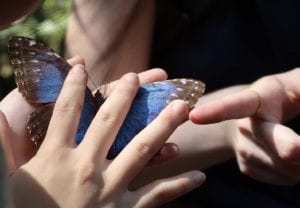In the afternoon, when looking for a cecropia tree, we naturally ran into the cecropia ant inhabitants. Our afternoon experiment will test whether or not young (not colonized by ants) cecropia trees will develop alternate (chemical, physical) defenses to herbivorous predators before they are colonized by ants and benefit from that defense. When we happened upon an adult cecropia tree, we got to see how they swarm out when it falls, and how the tree has evolved a hollow structure inside of it for the ants to live. The structure is an akin to the ants having high-rise apartments, because that tree is tall! Cecropia ants all fall under the Azteca family, and I think we saw Azteca alfari based on the looks. After we saw the big cecropia tree & colony, we set out to find the young uncolonized tree. While we searched, we happened upon two more really cool ant phenomena. The first, we saw a young leafcutter ant colony. We could tell it was young for two reasons: a) the colony entrances were small. there were multiple, indicating an age greater than one year, but still relatively small and therefore young. b) the ants were bicolored (red head and abdomen and a darker thorax.) Dr. Solomon did some inconclusive research as to why leafcutter ants may be discolored, but he discovered that ants were bicolored when the colony was young, which is how I know that colony is young! After the young colony, we saw an ant I hadn’t seen yet or even researched: theCamponotus sericeiventris, or Carpenter ant (but it directly translates to “Golden butt” ant, which is more fitting.) After we saw these two ants, we found the young cecropia tree, which was supposed to be uncolonized, but the one we found had one singular inhabitant: the queen! It was super cool to see her working in the little tree before her colony and her tree grew (her colony and tree did not grow because we cut it down unfortunately.) Overall, it was another fun and interesting day to be the ant man, and I know tomorrow will be even better as we are to spend the afternoon investigating leafcutter ant colonies! What a treat!
Tag Archives: Azteca ants
19/05/19 I finally caught a blue Morpho.
6:00am breakfast as usual. In the morning, the class hiked up the Maya Trail to examine an area disturbed by a hurricane a few years ago. The damage was apparent in the tree fall, but also in the difference in species composition between the disturbed and undisturbed areas of the rainforest—most notably, cecropia trees inhabited the disturbed areas abundantly, but not the undisturbed areas. The class surveyed plant species in both disturbed and undisturbed areas of the rainforest along the Maya Trail.
On an exciting note, I finally caught a blue Morpho! The butterfly made the mistake of settling on a leaf too close to me and not darting away while it had the chance, thinking that its leaf-like underside camouflage would save it. This bad boy was rather large at a wingspan of around 13 cm (blue morphos can reach a wingspan of 20cm). These iconic rainforest species have an easily recognizable iridescent blue topside, but with wings closed (as butterflies have the tendency to perch), the brown underside with eyespots blends into the butterfly’s surroundings. Blue morphos are also incredibly adept flyers, making them difficult to catch both in flight and not.
Blue Morpho, Morpho peleides
That afternoon, the class returned to the hurricane-disturbed area along the Maya Trail to examine firsthand the ant-plant mutualism between cecropia trees and the Azteca Ants that inhabit and defend them.
That night, the class hiked up the PAINfully steep bird tower trail to the bird tower. Although the hike was hard and the sky was cloudy, the stunningly beautiful view from the bird tower was unparalleled. The class spent over an hour at the bird tower until the sun began to set. I sat with my feet dangling off of the edge of the bird tower and enjoyed the breeze. We returned to the research station in the dark, and the downhill hike back was much easier. We saw a cave, and nearly stepped on a jumping pit viper, and at one point we all turned off our headlamps and (surrounded by darkness) just listened to the rainforest sounds.
(From left to right) Keegan, Cassia, Michael, Me on top of the bird tower
The class ended the day with lectures on fungus, reptiles, beetles, and a lecture from yours truly on tropical parasites, diseases, and medicinal plants.










